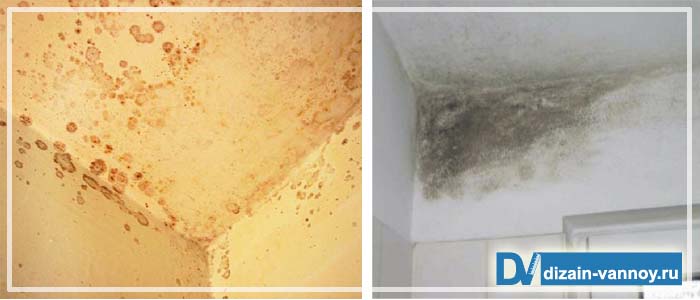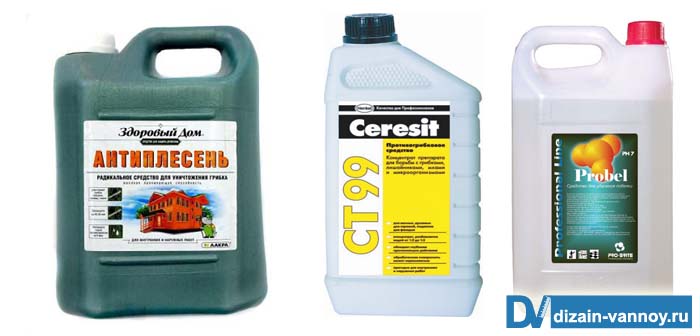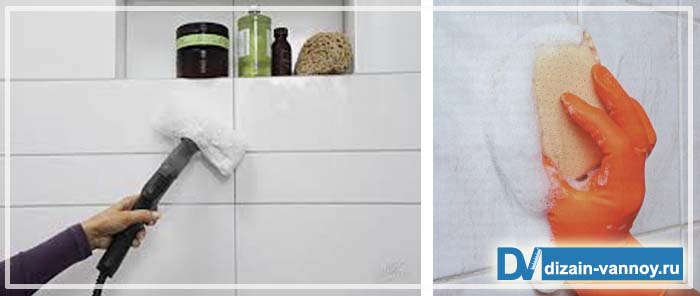Fungus in the bathroom: how to fight and why is it dangerous? Effective means and methods of struggle
Fungus in the bathroom is not only ugly. Mold spores can cause serious health problems. How to deal with a fungus in the bathroom if it suddenly attacked the bathroom, kitchen or any other room? What to do, how to quickly and permanently get rid of the fungus? In this article, we will look at what means will help remove the fungus in the bath area. An interesting fact is that fungal spores are present in almost any room, they just develop only under favorable conditions of high humidity and heat. Therefore, antifungal cleaning products that exist, every housewife must know. Let's figure out how to remove the fungus in the bathroom.
Especially often and unexpectedly for any hostess, the question arises: what are the best antifungal agents for the bathroom?
Why fungus appears and how to avoid it
It is in the bathroom that the conditions for the occurrence of a fungus are met: there is a lot of water, the heating works to its fullest in winter, or it’s just hot in the apartment in summer. The reason for the appearance of the fungus may be too many flowers in the house - they also increase the humidity of the room. Another reason for the appearance of the fungus is the incorrect redevelopment of the apartment, “thanks to” which the natural ventilation of the space is disturbed. Therefore, the question "how to remove the fungus in the bathroom?" almost every housewife asks: so often this unpleasant phenomenon occurs in apartments.
In general, you should take care of the possible appearance of the fungus even before it happens: there are preventive measures that will avoid this phenomenon.
For example, if you started a renovation, antifungal treatment of the walls will definitely save you from future troubles: do not spare time and money for this simple procedure - in the future you will be grateful to yourself for having shown such foresight. How to eliminate the fungus in the bathroom then would not be a question that might interest you.
- The fungus on the ceiling in the bathroom is especially common in apartments of old buildings, where the moisture insulation of the walls is not as good as in new buildings. Often, his appearance in the kitchen near the sink.
- Black fungus in the bathroom appears most often - he is a true lover of conductive water. So, how to clean the fungus in the bathroom from different surfaces? He can meet everywhere: black spots suddenly appear on plastic, brick, concrete, wood, paint, ceramics. Fortunately, there are special antifungal cleansers for these cases.
- Fungus in the bathroom is formed very often: the reason for this is high humidity. It is clear: the walls, ceiling and floor of the bathroom come into contact with water a large number of times, several times a day. There are both special chemical antifungal agents for the bathroom, and "grandmother's", folk methods.
How they see different types of fungus on the walls can be seen in the photo.

What is dangerous fungus in the bathroom? It's no secret that fungus and mold not only spoil the appearance of the room and destroy building materials, but can also cause serious illnesses or just allergies and poor health - it's not pleasant enough, agree?
Reference: The waste products of fungi that a person is forced to inhale are extremely toxic. Here are just some of the diseases that it can provoke in humans: bronchitis, pneumonia, eczema, dermatitis and stomatitis.
We destroy the fungus
The destruction of the fungus, if it did appear, must occur at a fast pace: otherwise the fungus will fill the entire surface of the walls and ceiling with itself - and it will be extremely difficult to get rid of it. Removing fungus in the bathroom with chemicals should be done with extreme caution: most of them are very dangerous to human health. Before figuring out how to kill the fungus in the bathroom, you should wear special protective clothing, gloves, and sometimes a respirator.
Chemicals

Bath antifungal should only be sprayed when there are no children or pets in the house. If a fungus has appeared in the bathroom, you need to think not only about how to urgently get rid of the fungus, but also about the causes: most likely, the cause is improper ventilation of the room, which constantly keeps the surfaces wet. Also, the reason why a wall fungus occurs can be a leakage of taps, a violation of the waterproofing of drain lines or water pipes.
For your information: The main anti-fungal agents in the bathroom are copper sulfate (the most budget option), Spectrum, PS 50, Snezhka impregnation and Titanium Fungcid. Copper sulphate is a tool, due to its price, very popular among people who are looking for how to treat the bathroom from the fungus. However, they should not get carried away: it is much more reasonable to spend money on a special modern tool. The fact is that the use of copper sulfate may get rid of one type of fungus, but can cause another.
How to destroy the fungus in the bathroom with chemistry? Another excellent anti-fungal agent in the bathroom is any chlorine-containing chemical, even ordinary whiteness. Remember that it is necessary to work with it with gloves, protecting the surface of the skin - this is an extremely toxic substance that can cause a chemical burn.

Sometimes it is impossible to avoid the appearance of fungus even in ordinary living rooms. It can appear in the bedroom, and in the living room, and in the nursery. If wallpaper is glued in the room, then the fungus on the wall with wallpaper should go through several stages:
- Cleansing the infected area - removing all layers up to concrete or brick, then treating with an antifungal agent.
- Then - an antiseptic primer.
- The next stage is the impregnation of the waterproofing mixture, plaster and putty.
After the walls are completely dry, the last step is wallpapering. Just completely cleaning the wall is the surest way to defeat the fungus.
Unfortunately, there is no way to finish walls and ceilings, which in itself would be able to resist the fungus - it can form on any surface that comes into contact with moisture. In the bathroom, the seams between tiles, silicone seals on the seams, showers are especially susceptible. In order to get rid of it, there are different ways for different types of surfaces. Let's consider the main ones.
How to remove mold from tiles

The fungus on the tile can be removed in a simple way - using ordinary hydrogen peroxide, and then simply keep the previously damaged area clean, periodically doing prevention with the same tool.
Consider a method that will tell you how to remove the fungus in the bathroom at the seams. It will require diligence and time, however, it is quite effective: therefore, we will pay special attention to it. To do this, you will need: a screwdriver (or any other sharp object with a “shovel” to fit the width of the seam), vinegar, baking soda or a chlorine-containing preparation (for example, ordinary whiteness), a hard toothbrush, a narrow brush, sandpaper, grout. So, removing the fungus between tiles is done in several ways:
- Method number 1. Quick. This will require the most common soda and vinegar or whiteness. Pour the liquid into the container, using a brush, go through all the seams between the tiles where you found the fungus. Then wipe the previously treated areas with water with a cloth (sponge) - it is necessary to completely wash off the solution. To fix the result, walk through the same places with a sponge or cloth with soda;
- Method number 2. We pour ordinary soda (this is an excellent antifungal agent) into a plate, take an old toothbrush. We moisten the brush with water, dip it in soda and carefully rub the areas of the inter-tile space damaged by the fungus. After rinsing the treated areas with water and wiping dry;
These methods, as practice shows, will get rid of the fungus - but only for six months. Most likely, it will reappear: we have cleaned the surface, but have not improved the situation dramatically. In order for the fungus on the tiles in the bathroom between the ceramic plates to disappear forever, there are more complex ways.
- Method number 3. Mechanical. Remember we needed a screwdriver? We take it in our hands, and completely remove the grout from the seams clean. The process is long and troublesome - but there is simply no more effective way than to get rid of the grout completely without dismantling the tiles. By doing this, we remove not only the fungus, but also its source. Be careful: unfortunately, the method is dangerous for the appearance of the bathroom in that you can easily damage the tile itself. After you need to process the resulting cracks with vinegar, and then re-apply a new grout.
Removing mold from sealant

Fungus on the sealant, which often fills the seams in the bathroom, is also extremely susceptible to the occurrence of fungus. Just completely removing the sealant and completely updating the joint is a troublesome and expensive task. Moreover, the result is enough for a maximum of six months or a year: after the fungus returns again. The fungus on silicone without treatment with special means will not disappear anywhere. Therefore, the treatment of the bathroom from the fungus on silicone sealant, ideally, should also consist of several stages:
- Removal of old sealant;
- It is necessary to walk through this place with a blowtorch, that is, literally burn out the entire fungus;
- Apply new sealant.
Only in this case it is more likely that the fungus will not appear again. Of course, for this you need to observe the general climatic conditions in the room, as we wrote about above.
Furacilin against fungus

How else and how to treat the fungus in the bathroom? Furacilin from the fungus in the bathroom can also save. This is a good mold remover. This will require 1 tablet of furacilin per liter of water (more is not required). You just need to treat the surface with furatsilin. Many claimed that after several such procedures they forgot what the fungus looks like - this remedy is so effective for some of its species. Try it: perhaps such a simple budget remedy for fungus in the bathroom will save you.
Conclusion
After you have completed all the procedures, it is necessary to monitor the good weathering of the room, which is prone to the appearance of fungus, and in the future this ailment can be avoided. To do this, it is very useful to create a draft in the room - to open windows and doors, especially in windy weather.






